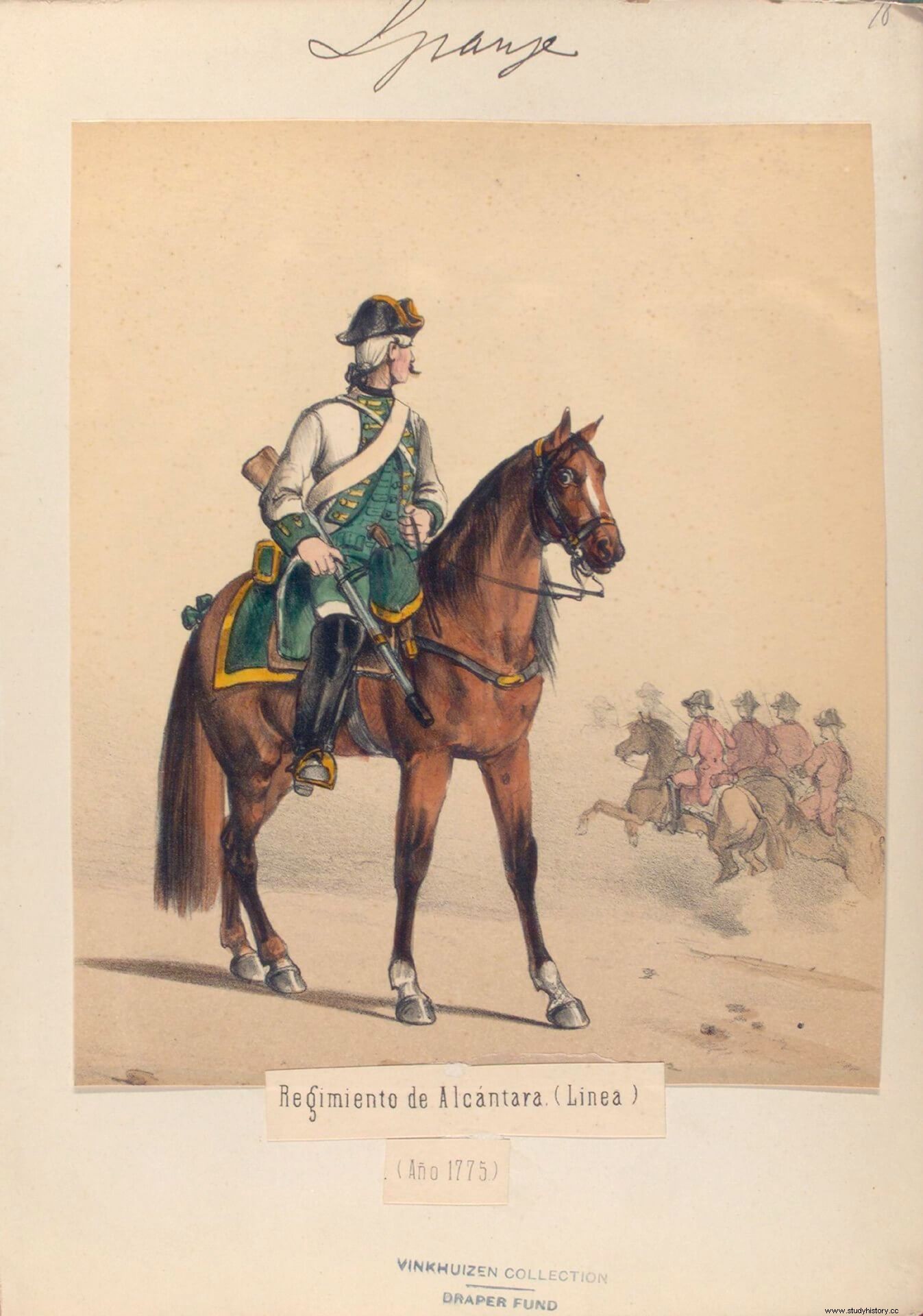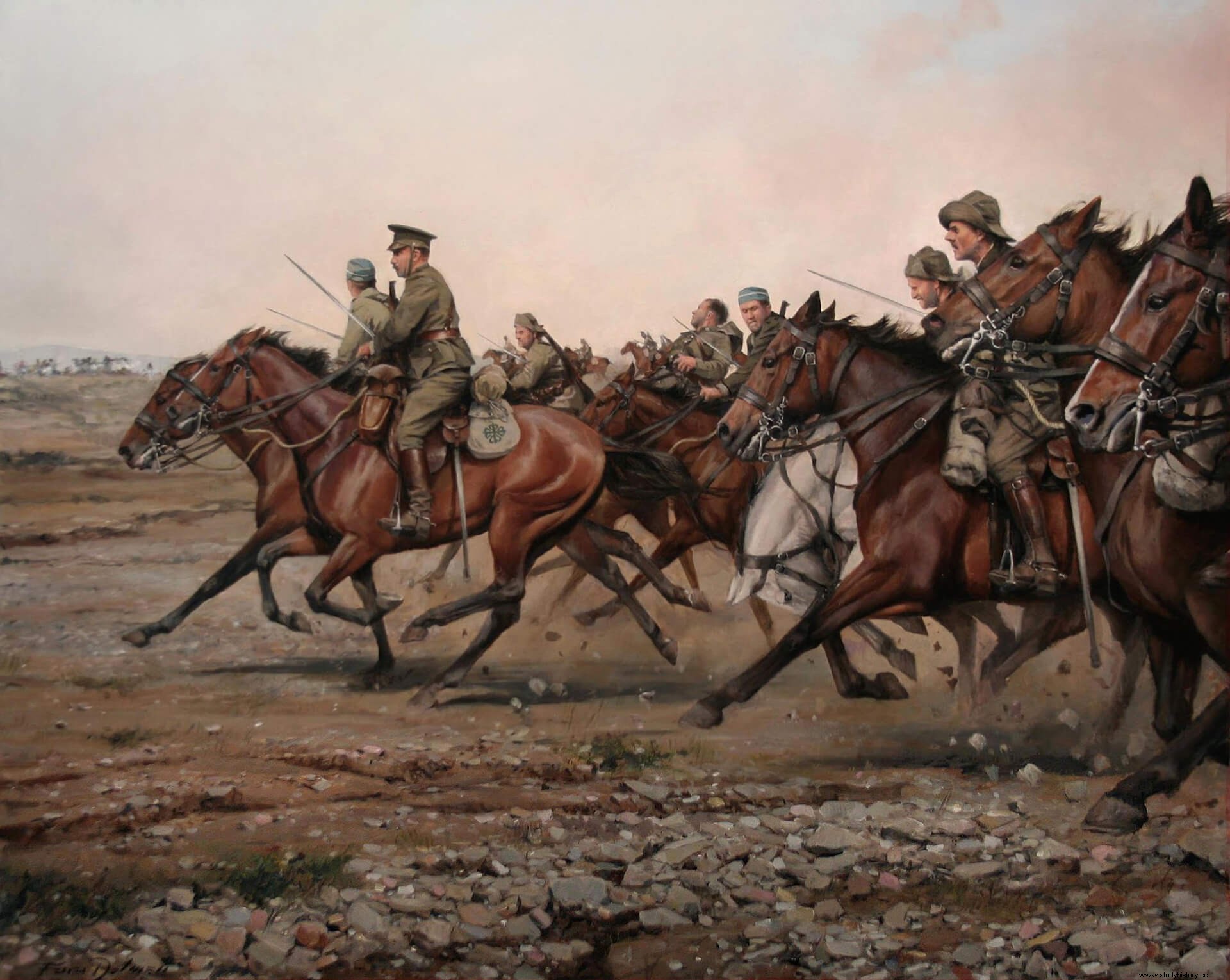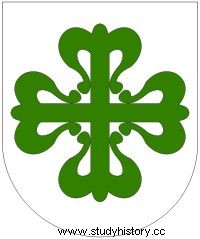As it happens with all the regiments that existed in the year 1899,[1] there is a copy of the history of the Alcántara Cavalry Regiment guarded in the General Military Archive of Segovia; however, it is surprising that everything that appears in said archive until the year 1851, after the reorganization of the cavalry arm by a royal decree of December 9, is a copy -handwritten and certified by the one who was in 1899 commander-in-chief of the same [2]– from the work of the Count of Clonard Organic history of infantry and cavalry arms […] .[3] In addition, and unfortunately, the original of the history was lost in the middle of the last century, so a fundamental primary source for understanding the actions of the unit between 1903 and 1965 disappeared.
The origins of Alcantara
Despite interested versions that mark the formation of the Alcántara in the eleventh century, we must look for its origin in the mid-seventeenth century as it was created in 1656 due to the need to increase forces in Flanders, by Felipe IV, due to the war with France.[4] The person in charge of organizing this new cavalry tercio was the field maestre Juan Francisco Nestien, so this, as was tradition, took the name of the maestre who commanded them:Nestian Cavalry Tercio . Subsequently, it would change its name by virtue of who directed it until, in 1718, by ordinance, all units were forced to fix their name, and it was renamed the Alcántara Cavalry Regiment, which was recognized as dating back to the February 19, 1656, date on which the first soldada was collected.

The regiment was very active from its inception. Its first renowned combat took place on July 16, 1656 at the siege of Valenciennes, when the unit charged the French with the cry of kill, kill![5] and annihilated 18 Gallic squads; but he suffered a great defeat in the action of the Dunes in 1658 and, a year later, the Peace of the Pyrenees was signed. He would fight again in the second, third and fourth wars against France. In 1696 the Tercio moved to Barcelona, where it would continue to be a protagonist in the combats of Ter, Hostalrich and the defense of Barcelona against the French siege in the summer of 1697; in 1701 the regiment was sent to Italy and, during the War of Succession , fought outside and inside the peninsula. Years later, he also participated in the fight against the Quadruple Alliance (1717-1719) and, later, in 1727, in the siege of Gibraltar, a destination to which he would return with the same success in 1779. Between 1733 and 1736 he was in Italy with occasion of the War of Polish Succession; in 1762 he is the protagonist in what is known as the Seven Years' War; in 1792 he took part in the Roussillon War and in 1801 he participated in the War of the Oranges.
The War of Independence and the turbulent 19th century
On July 31, 1803, a new regulation resulted in the assignment of numbers to each regiment and the first that the one in question bore was the 7th of the line . The numerals will vary, with some ease, until today.
The uprising and the War of Independence (1808-1814) surprised split regiment. Two squadrons were in Portugal under the French General Junot, while the others resided in San Roque. Both groups experienced very different fates and while those from San Roque moved to Villa de Arahal, where their squad was completed until reaching the number corresponding to a regiment, the squads that were in Portugal were disarmed and imprisoned, and remained on a pontoon anchored in the Tagus River until the English navy released them in the summer of 1808, after which they were transferred to Tarragona to join the original regiment by Royal Order of June 30. In 1812 the unit participated in the defense of Valencia and later in that of Vélez Rubio. At the end of that same year, the Húsares de Torralba merged in the Alcántara.
The Riego pronouncement and the events that derived from that coup d'état had as a consequence, by royal decree of October 11, 1823, the dissolution and extinction of all the cavalry units with the exception of the Almansa Regiment, which that day was the escort of Fernando VII. The Alcántara would not be created again until 1844.
Transferred to Barcelona and Mataró in 1867, he participated in the so-called "political events" and, during the month of August, took part in different skirmishes, among which the "brilliant charge" stood out [6] in the Bruch; Similar events would be repeated in 1870 in the surroundings of Barcelona. With the start of the Third Carlist War (1872-1876), the Alcántara intervened, during the summer of 1872, in "quite a few armed struggles that repeatedly resulted in deaths, injuries and Carlist prisoners"[7] and had a notable and intense performance in the area of Catalonia throughout the campaign. In 1896, as a result of a telegram received on November 30, the Alcántara must allocate a corporal, a trumpet and twenty soldiers to the newly created Regiment of Hunters of Alfonso XIII, who with a stopover in Seville will head for Cuba.
From Cuba to Morocco
The end of the Spanish-American War , the losses of the colonies in America and the international scene, with its diplomatic, geostrategic and prestige pressures, resulted in Spain becoming involved in Africa. On September 10, 1911, the Alcántara Regiment, which had traveled aboard the steamship Luis Vives, landed in the port of Melilla. From the first moment it took center stage in the area. In 1913 he participated in the Kert Campaign, where he stood out in the action of Ras el Medua, and the following year he was part of the occupation of Monte Arruit. From that moment, Morocco would be a relatively calm territory until the events surrounding the Annual disaster (summer 1921), during which the unit witnessed and participated in the events from all prominent positions, and was forced to charge repeatedly. In those days he wrote the pages that the Cavalry Academy shows and instills in his students as the most glorious of the Spanish cavalry. Due to his behavior, King Juan Carlos I would grant him the collective Laureate by Royal Decree 905/2012, of June 1, by which the Laureate Cross of San Fernando is awarded, as a Collective Laureate, to the Regiment of «Hunters of Alcántara, 14 Cavalry» .

The Annual disaster practically annihilated the regiment, of which only one squadron could be reorganized, mainly to cooperate in the defense of Melilla and carry out escort missions. During the month of September 1921, new equipment and horses began to arrive, and personnel were incorporated – survivors of the disaster and volunteers – with whom they were able to form two other squads of very small troops that, despite this, were protagonists in actions of renowned as the taking of Nador that same month. The regiment was to take months to normalize.[8] The popular recognition of his performance was rewarded with monuments and tributes throughout the national territory.
From the Civil War to the UN humanitarian missions
In 1930, with the exception of two sections of escorts and honors that were assigned to Ceuta and Melilla under the dependency of the Cría and Remonta Caballar detachments, the regiment returned to the peninsula , specifically to Badajoz, where it merged with the prestigious Villarobledo Regiment. In 1931 the unit received 32 machine guns and became an armored force, but shortly thereafter it was disbanded and its entire staff assigned to the new Gun-Automachine Gun Group. Shortly after the Alcántara would be transferred to Aranjuez, where it was at the outbreak of the Civil War , in which he fought for the Republic. The events of the Alto de los Leones on July 21, 1936 led to its dissolution, since taking advantage of the ascent to the port a large number of officers went over to the enemy, in addition to the loss in combat of a large part of the armor.
After the war, the Exploration and Exploitation Groups were created, and the names of the units were not recovered again until a royal decree of 1943 by virtue of which, based on the 19th Mixed Cavalry Regiment, the 15th Alcántara Dragoons was created , which was sent again to Africa, specifically to Larache. With the independence of the Kingdom of Morocco in 1958, he not only lost his destiny and moved to Jaén, but also took a step back, handed over all his mechanized material, recovered his saber and horse and became a Hunter. This was the only case in the entire cavalry, although for a short time, since in 1960 it became the Armored Group of Cavalry Alcántara No. 15 and took again the logical mechanized look of the time. Three years later he changed his rating from group to regiment.

In 1965 he moved again to Melilla with the denomination From the 10th Light Armored Cavalry Regiment, in 1974 it became just the 10th Alcántara Armored Cavalry Regiment, and currently and since 2017 it is simply 10th Alcántara Cavalry Regiment . He has participated in humanitarian missions in Kosovo and Lebanon; and has also formed a team of 13 people whose mission was to train the Iraqi army and provide the Public Information Officer (PIO).[9]
Motto
Hymn of the Alcántara Cavalry Regiment
Author:Julio Moreno Rodríguez
Denominations
1656.- Nestien third.
1675.- Du Puys third.
1692.- Gourdin third.
1607.- Alcántara Regiment, 7th Cavalry.
1808.- 1st Alcántara Cavalry Regiment (There was a 2nd Alcántara with which it merged).
1811.- Alcántara Line Cavalry Regiment (or 2nd Alcántara).
1814.- Alcántara Cavalry Regiment, 7th line (disbanded in 1823[10]).
1844.- Alcántara Cavalry Regiment, 4th Lancers.
1848.- Alcántara Cavalry Regiment, 5th Lancers.
1849.- Alcántara Cavalry Regiment, 3rd Lancers (renamed Bourbon in 1851).
1851.- Alcántara Cavalry Regiment, 16th Lancers (newly created).
1859.- Alcántara Hunters Regiment, 16th Cavalry.
1865.- Alcántara Cavalry Regiment, 2nd Chasseurs.
1874.- Alcántara Hunters Regiment, 14th Cavalry (disbanded in 1931[11]).

1944.- Dragoons of Alcántara Cavalry Regiment n .º 15.
1957.- 15th Alcántara Hunters Cavalry Regiment.
1960.- 15th Alcántara Cavalry Armored Group.
1963.- 15th Armored Cavalry Regiment Alcántara.
1965.- 10th Alcantara Light Armored Cavalry Regiment.
1974.- 10th Armored Cavalry Regiment Alcántara.
2017.- Alcántara Cavalry Regiment 10.

Histories you have received
1769.- Brabant Cavalry Regiment.
1927.- Vitoria Chasseurs Regiment, 28th Cavalry.[12]
1927.- Taxdirt Chasseur Regiment, 29th Cavalry.
1930.- Villarobledo Hunters Regiment, No. 23 cavalry.
1959.- Tabor de Melilla No. 2.
1965.- Light Armored Group or Reconnaissance Group II.
Civilian and military decorations, rewards and distinctions
- Cruz Laureada de San Fernando for the events arising from the Annual disaster.
- three ties from San Fernando.
- two Military Medal ties[13].
- Gold Medal of the City of Melilla. Received for its connection to Melilla and especially for its behavior in the Annual disaster and in the Melilla floods of 1985.
Main bibliography
- Lieutenant General Count of Clonard (1859):Organic history of the Spanish infantry and cavalry arms, from the creation of the permanent army to the present day . Volumes XIV and XVI. Madrid:Francisco del Castillo Printing House.
- VV/AA (2015):Alcántara Regiment, 10th Cavalry. Notes on your history. Uniforms and Banners . Melilla:Gaselec Foundation.
- Manzano, A. (2012):The Alcántara Regiment (1911-1921). Dispels, like the sun, the clouds in its path . Madrid:Athena Group.
- (2013): Alcantara. A laureate of life . Madrid:Ministry of Defense.
- (2016):Excerpt from the History of the 10th Cavalry Regiment . Madrid:Ministry of Defense.
- VV/AA (2013):“Let the Figures Speak” History of the Laureate of Alcántara . Melilla:UNED.
Unpublished:
- History of the Cazadores de Alcántara Regiment, 14th Cavalry. Since it was created in 1656 until the end of 1903 . General Military Archive of Segovia.
Notes
*Due to the large number of discrepancies that exist in different sources consulted on the Regiment's history, the primary sources have been taken as the main reference, that is, all the unpublished files guarded in official bodies.
[1] In compliance with the royal order of April 26 (official newspaper 92)
[2] Palm Sunday and Rye
[3] Lieutenant General Count of Clonard (1859):Organic history of the Spanish infantry and cavalry arms, from the creation of the permanent army to the present day , volume XIV, pp 324 and ss. Madrid:Francisco del Castillo Printing House.
[4] First war against France, 1648-1659.
[5] Clonard, p. 334.
[6] General Archive of Segovia (AGS). History of the Cazadores de Alcántara 14th Cavalry Regiment. Year 1867, p. 3.
[7] AGS. Year 1872, p. 2.
[8] According to interviews with descendants of Alcántara officers who lived in Melilla in the 1920s and 1930s, he was never the same.
[9] Public Information Officer.
[10] In 1824 the Regiment of Lancers Defenders of the Sovereign was created, which that same year would be renamed the 8th Provisional Cavalry Regiment. In 1826 it changed its name to the Bourbon Cavalry Regiment, 5th line; and in 1841 to the Bourbon Regiment, 5th Cavalry. Based on this regiment, the Alcántara was reborn in 1844.
[11] His personnel are moved to the Automachine Gun Group-Cannon. In 1939 the Exploration and Exploitation Group No. 9 was created, which a year later became the 19th Mixed Cavalry Regiment and in 1943 the 19th Independent Cavalry Regiment and that same year the 19th Mechanized Cavalry Regiment Based on this, the Alcantara is formed again.
[12] It was refounded and integrated into the Alcántara in 1944.
[13] These 5 ties are held by having received the records of Tabor Melilla No. 2, which in turn collected the records of other indigenous units.
